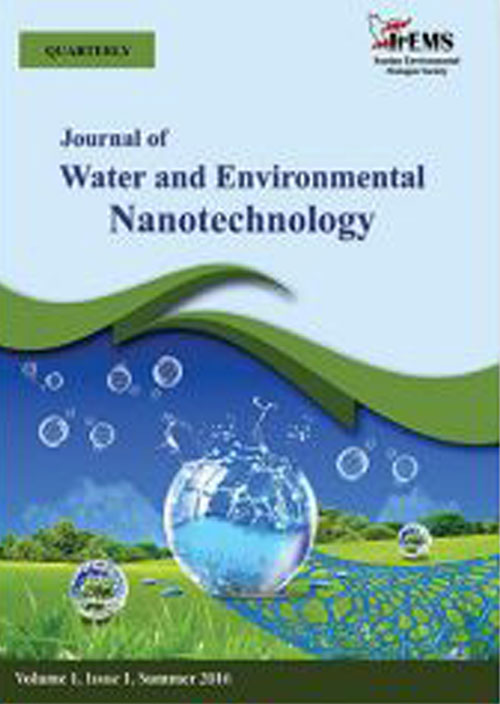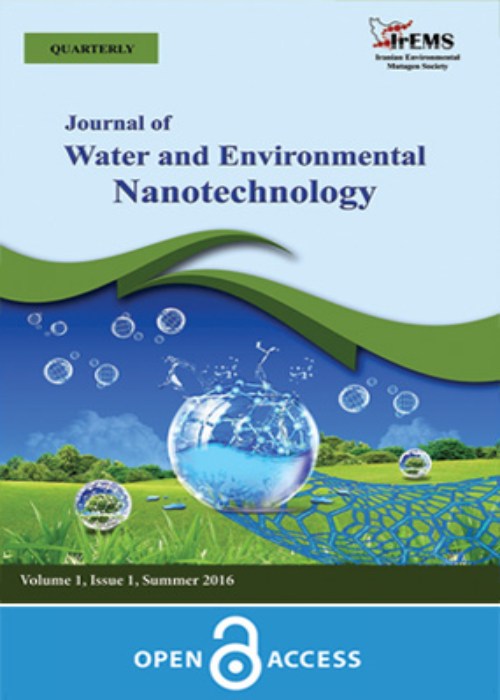فهرست مطالب

Journal of Water and Environmental Nanotechnology
Volume:6 Issue: 2, Spring 2021
- تاریخ انتشار: 1400/05/03
- تعداد عناوین: 8
-
-
Pages 92-108Sol–gel method was applied for synthesis of TiO2 nanoparticles in the existence of different volumes of ethanol (10–50 mL) with the purpose to find optimized synthesis conditions. Also, nickel doped TiO2 nanoparticles (Ni/TiO2 molar ratio: 0.1-1.0%) were prepared by the similar technique but in the existence of 10 mL ethanol and heated at different temperatures (300 °C –600 °C). XRD, SEM/EDX, UV-Vis DRS, FTIR and Raman spectroscopy were applied to identify the structural and morphological characteristics of the as-synthesized samples. XR diffraction results verified that TiO2 samples prepared with various volumes of ethanol (10–50 mL) consist of anatase and brookite phases up to 500 °C and rutile phase at 600 °C. The intensity of brookite diffraction decreased with the increase of calcination temperatures. Also, the low ethanol volume favored for formation of rutile phase at 600 °C. The addition of Ni(II) during the preparation of TiO2 nanoparticles prevented the formation of rutile phase. The undoped samples were synthesized with 10 and 20 mL ethanol and treated at 500 °C displayed the best catalytic performance for photocatalytic treatment of E 131 VF dye solution (rate constant: 0.051 and 0.061 (a.u) respectively). Ni doped TiO2 samples displayed lower photoactivity and rate constant.Keywords: Sol-gel, Ni, TiO2, Ethanol, Food dye E 131 VF, Kinetic study
-
Pages 109-120Tri-ethylene glycol (TEG) coated Fe3O4 nanoparticles ferrofluid were used for Pb (II) removal from simulated wastewater. The samples were synthesized using a modified co-precipitation method. The prepared samples were characterized by different techniques including X-ray diffraction, Rietveld method, FTIR, FESEM, TEM, VSM, TGA, BET and atomic adsorption experiments. The crystallinity of nanoparticles with a cubic spinel ferrite structure and absence of impurity phases were verified using X-ray diffraction and Rietveld method. The presence of TEG was approved by FTIR and thermogravimetric analysis. The VSM results showed that the bonding between the TEG molecules and ferrite nanoparticles, reduces the surface spin disorder, influences the morphology and magnetization, and consequently increases the Pb (II) removal efficiency to a high value of 97%. The obtained high value of adsorption capacity of q=363.4 mg.g-1 with R= 91 % and q=129.4 mg.g-1 with R=97 %shows effective role of TEG coating on Pb (II) adsorption. The interesting results of this study imply that the TEG coated ferrofluid sample is suitable candidate for practical applications.Keywords: TEG-Fe3O4, Coating, Magnetization, Pb(II), Adsorption
-
Pages 121-137Arsenic contamination poses a major public health concern and harms the environment with its toxicity. Long term exposure to a high concentration of arsenic is harmful to human health as well as the environmental biodiversity. This study is aimed to fabricate and investigate the possibility of polyethersulfone-graphene oxide-polyvinyl pyrrolidone (PES-GO-PVP) nanocomposite adsorptive membrane and use it to enhance the removal of arsenic from wastewater. The nanocomposite membrane in this study was fabricated via the non-solvent induced phase separation (NIPS) method with the addition of polyvinylpyrrolidone (PVP) as a pore-forming agent. Based on the characterization results of GO through Fourier-Transform Infrared Spectroscopy (FTIR), X-ray diffraction (XRD) and Raman spectroscopy, the existence of high quantity of oxygen based functional groups with high degree of oxidation was observed, which indicated that the GO were well-synthesized. The characterization of the membrane indicated that the addition of GO and PVP could impact the membrane hydrophilicity and mechanical stability. Three adsorption parameters (initial concentration of arsenic, pH and contact time) were then optimized using a face-centred central composite design (FCCCD). The arsenic removal efficiency of 88.6 % was obtained with 55 mg/L of initial arsenic concentration, at pH 8 and 75 minutes of contact time between PES-GO-PVP membrane and the arsenic ion. The Langmuir isotherm model fitted the equilibrium data, describing the monolayer adsorption mechanism occurred on the surface of the membrane. Therefore, the results obtained in this study prove the suitability and promising potential of the nanocomposite membrane for effective removal of arsenic through adsorption.Keywords: Graphene oxide-based membrane, Characterization, Adsorption, Optimization, Adsorption isotherm
-
Pages 138-149In this study, zeolitic imidazolate framework (ZIF-8) nanocatalyst was synthesized by the thermal solvent method and doped by Fe species through wet impregnation technique. The nanocatalysts were applied for the degradation of Phenazopyridine Hydrochloride (PHP) through the heterogeneous Electro-Fenton (HEF) process. The nanocatalysts were characterized by XRD, BET-BJH, FT-IR, FE-SEM, TEM, and acidimetric-alkalimetric titration techniques. The results showed the high surface area (1335 m2g-1) and homogenous dispersion of Fe species. The influence of different operating conditions was investigated, including pH level, nanocatalyst concentration, applied current, and PHP concentration. The optimum conditions for the HEF system over the Fe-ZIF-8 nanocatalyst were pH=7, 0.2 g L-1 of the Fe-ZIF-8 nanocatalyst, 100 mA, and 10 ppm of PHP concentration, which resulted in 99% PHP removal. The developed nanocatalyst had high reusability for the PHP removal in the HEF process. The results confirm the high potential of ZIF-8 nanocatalyst for pharmaceutical wastewater treatment through the HEF process.Keywords: Water treatment, Electro-Fenton, nanocatalyst, Metal-organic framework, ZIF-8
-
Pages 150-163Nowadays, not only the lack of water sources but also water pollution by industrial wastewater has become a major challenge. One of the pollutants of water resources, which threatens water resources, is phenol that enters the environment through wastewater from various industries such as petrochemicals, refineries, pharmaceuticals, etc. This compound, due to its toxicity, high stability and solubility in water caused many problems and it is very important to remove it from industrial wastewater. Therefore, the main purpose of this study is to remove phenol from wastewater by using catalytic oxidation. Fe-ZSM-5 catalyst was synthesized by precipitation method and its characteristics were determined by XRD, FTIR, SEM and BET analyses. The results of XRD analysis showed that the iron ions are in the MFI structure and the catalyst has a good crystallinity phase, so that it retains its MFI structure. BET analysis showed the specific surface area of the synthesized catalyst is 293g/m2. The catalytic activity of Fe-ZSM-5 was investigated in degradation of phenol and the results showed that the mentioned catalyst had the highest removal percentage (85.82%) in 90 min at pH = 4.25 and T= 70 °C. The effect of various parameters such as ultraviolet radiation, initial pollutant concentration, catalyst loading and H2O2 concentration on the catalytic activity were also investigated.Keywords: Catalytic oxidation, Fe-ZSM-5, Phenol, Wastewater treatment, Ultrasound Waves
-
Pages 164-176In the present work, the sol-gel derived powders of the chemical form FeCr2O4@ZnO@MgO Core-shell, has been synthesized and used as a photocatalyst. The synthesized core-shell nanoparticles characterized by various analytical techniques including FTIR, XRD, SEM-EDAX, and HR-TEM-SEAD. The successful performance of synthesized core-shell photocatalyst FeCr2O4@ZnO@MgO has been also demonstrated for the complete mineralization of Orange G dye. The effect of various operational parameters used in dye degradation such as concentration of dye, light intensity, amount of photocatalyst, effect of light and effect of electrolyte has been studied on the rate of reaction. TEM analysis clearly shows two layers of ZnO and MgO on FeCr2O4. The highest degradation rate was found with concentration of Orange G dye 10 ppm, 0.8 g of FeCr2O4@ZnO@MgO and time 50 min. The recyclability of the photocatalyst, FeCr2O4@ZnO@MgO was performed up to four runs. The degradation mechanism has been established by using LC-MS analysis and it was used to track the numerous intermediate products formed during the course of Orange G dye degradation.Keywords: Sol-gel, Photocatalytic degradation, Orange G dye, LC-MS
-
Pages 177-187A simple chemical methodology has been adopted for the synthesis of zirconium (Zr) doped and un-doped cadmium selenide (CdSe) nanoparticles for the application towards photocatalytic degradation of indigo carmine (IC) dye under solar light irradiation. The as prepared Zr-CdSe (doped) and CdSe (un-doped) nanoparticles were characterized by ultraviolet visible spectroscopy (UV-vis), X-ray diffraction (XRD), Scanning electron microscopy (SEM) coupled with energy dispersive X-ray analysis (EDAX) and Transmission electron microscopy (TEM) studies. The inclusion of Zr ion into the CdSe nanoparticles matrix was confirmed by SEM-EDAX and XRD studies. TEM studies confirm the zirconium ions are uniformly doped over the CdSe surface. The photocatalytic degradation performance of Zr doped and un-doped CdSe nanoparticles were examined for the degradation of IC dye under solar light irradiation. The experimental results showed that the Zr doped CdSe possessed greater photocatalytic activity in comparison to un-doped CdSe. Photodegradation process parameters such as the initial concentration of the dye, as well as the amount of catalyst and time were investigated. The photocatalytic degradation rate was favored by a high concentration of solution in respect to Langmuir–Hinshelwood model.Keywords: Zr doped CdSe nanoparticles, indigo carmine dye, solar irradiation, Photocatalysis
-
Pages 188-195
Decreasing the heavy metals availability has important key factors in environmental studies. This research was done to investigate the effect of nano-Fe oxide and nano-hydroxyapatite (NHAP) on Cd uptake by plant that cultivated in the sewage sludge amended soil. Treatments consisted of applying Cd (0, 10 and 20 mg Cd/kg)-polluted sewage sludge at the rates of 0, 15 and 30 t/ha, nano-Fe oxide (0 and 0.5 ppm) and NHAP (0, 0.5 and 1 % (W/W)). The plant in this experiment was pinto bean (Cv. Khomein). After 90 days, the plants were harvested and the plant Zn, Cd and Fe concentration was measured using AAS. In addition, soil microbial respiration was calculated. Soil application of NHAP significantly increased the Zn and Fe concentration of the plants that cultivated in the soil which was amended with 15 t/ha sewage sludge by 12.8 and 14.5%, respectively. However, the Cd concentration was decreased by 17.2%. Using 15 and 30 t/ha sewage sludge significantly increased the plant Zn and Fe by 13.1 and 14.6%, respectively. Foliar application of nano-Fe oxide ate the rate of 1 ppm significantly decreased the plant Cd uptake by 18.3%. Using NHAP (0.5 % (W/W)) and sewage sludge (30 t/h) significantly increased the soil microbial respiration by 14.2 and 15.3%, respectively. The results of this study showed that using organic amendments such as NHAP and sewage sludge or foliar application of nano-Fe oxide can affect in decreasing the heavy metal uptake by plants that is a positive point in environmental studies.
Keywords: Sewage sludge, CD, NHAP, Remediation, Nano-Fe oxide


